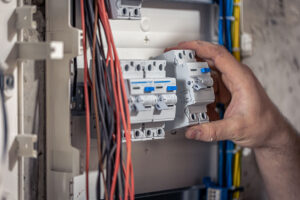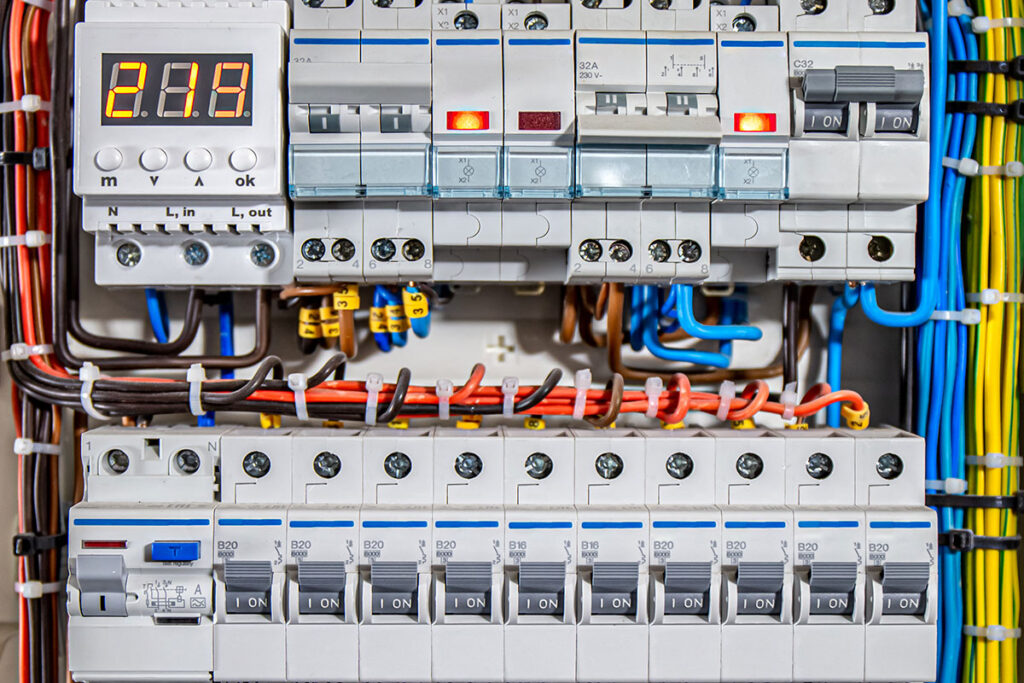Google Reviews ⭐⭐⭐⭐⭐

Ensuring the longevity and proper operation of your switchboard and safety devices is crucial both at your home and workplace. That’s why you need to invest in high-quality equipment that won’t let you down in case of a fault. One of the most important safety features of any electrical system is the safety switch.
This switch is particularly designed to protect people if something goes wrong and will cut off power in a few milliseconds (less than 0.03 seconds). It’s also known as a disconnect switch or load break switch and serves multiple purposes.
Its main function is providing fault protection for heavy machinery motors. Let’s find out more about this essential device and why installing it in your electrical system holds significant importance.
How Does A Safety Switch Work?
It is implemented to monitor the flow of current. If a defect takes place in the electrical system, there is a high risk that the electricity will inadvertently move to a nearby human body. This device detects when the current begins to flow toward a person rather than the equipment and shuts down the system in a matter of seconds.

Types Of Safety Switches
When it comes to ensuring safety in various devices, the installation of safety switches is a common practice. These switches can be categorized into different types depending on their specific functions. However, it is extremely important to specify the right type of safety switch that is suitable for a particular device to ensure maximum protection from potential electricity dangers.
1. Switchboard Safety Switches
The switchboard safety switches are specifically designed to be installed on the main switchboard. They have the important function of providing circuit protection for either the selected circuits or the entire installation.
2. Power Point Safety Switches
These safety switches are electronic devices developed to replace PowerPoint outlets. Their primary function is to ensure the protection of a single point or circuit from electrical overload, short circuits, and other potential hazards that may arise.
By installing these switches, users can have improved safety and peace of mind knowing that their electrical systems are completely secured and protected from any potential risks.
3. Portable Safety Switches
It play a key role in guaranteeing the safety of people working with various electrical devices simultaneously, including power tools. They are usually preferred when the PowerPoint safety switches or the switchboard safety switches are not readily accessible.
It may require some upfront costs, but the peace of mind it brings far outweighs the expenditure. We all are fully aware of how dangerous electricity can be, so why not take proactive actions to eliminate this risk?
Therefore, make sure to stay on top of safety measures by prioritizing the installation of these safety switches.
What Protection Do Safety Switches Offer?
Besides safeguarding your property and personnel, safety switches also offer reliable protection against the following:
- Overcurrent
- Circuit overloads
- Short-circuiting
- Heat-generated damage
It is designed to interrupt the power in case of a single fault in the circuit.

Installing Safety Switches
It’s important to ensure that safety switches are installed by a skilled and trained professional to prevent any potential danger. It’s worth investing in these relatively inexpensive switches to guarantee your safety.
Additionally, it may be helpful to consult with your electrician to determine the best placement for these devices. They will have the expertise to ensure proper installation in every circuit. The estimated fees of the electrician you hire can vary based on the size of the building and the number of safety switches required.
Are Safety Switches Suitable For All Settings?
When it comes to commercial and industrial settings, safety switches are a must-have. However, before using them, there are some important things to keep in mind. Make sure to cover the switch appropriately and post a warning sign nearby to ensure maximum safety.
Additionally, never perform wiring while power is supplied, as this can lead to an electric shock. In addition to that, also try to follow the below-mentioned precautionary measures in order to maximize your safety:
- Never insert fingers or other objects in an outlet.
- Keep metal objects away from every type of switch.
- Avoid using anything with a plug around water.
It is important to ensure that it is properly maintained and cared for. If they are not, they may ultimately contribute to electrical hazards instead of being the protective measure they are intended to be. Following all of these mentioned details can certainly help you prevent dangerous situations from arising. Call Sydney Electrical Service at 0433 462 902
FAQ’s
Where Can Safety Switches Be Found?
It is typically located in the electricity box, which is usually found in the front of the property near the power meter or in a cabinet or cupboard inside the property. It may vary depending on how they are manufactured. Installing a it on each circuit breaker is essential in order to ensure maximum safety and protection.
What Is A Common Example Of A Safety Switch?
If an individual unintentionally makes contact with a wire carrying an electrical current, the safety switch can detect the occurrence and immediately cut off the power supply. This immediate action effectively prevents the individual from being subjected to the dangers of electric shock, thus ensuring their safety and well-being.
What Is The Difference Between A Non-Fusible And A Fusible Safety Switch?
When it comes to electrical circuits, there are commonly two types: fusible and non-fusible. While both are reliable, it’s important to consider the level of protection against over currents and other electrical mishaps. This is where a fusible safety switch comes in.
A fusible switch has a fuse provision within the switch and enclosure assembly, allowing you to safely open and close the circuit while providing strong overcurrent protection.
On the other hand, non-fusible switches lack an integral fuse option and therefore offer no circuit protection. It’s crucial to carefully evaluate your requirements and choose the appropriate type of switch to ensure maximum safety and reliability of your electrical system.









